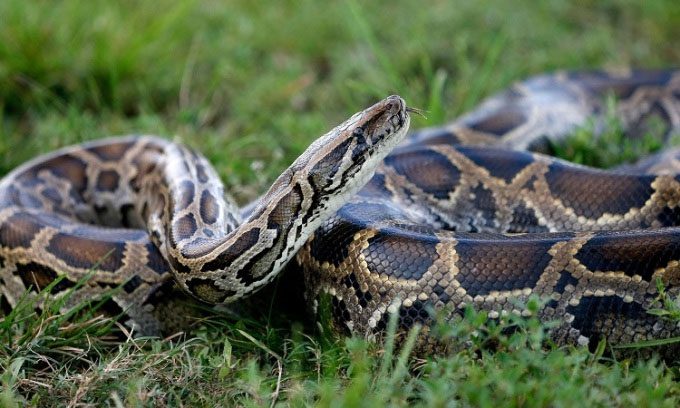Hurricane Andrew in 1992 devastated a breeding facility for Burmese pythons, likely allowing hundreds of Burmese pythons to escape into the wild.
Researchers are uncertain how exactly the Burmese python survived in Florida, but one theory suggests that this invasive species began to spread in 1992 when Hurricane Andrew destroyed a reptile breeding facility near Miami, facilitating the escape of Burmese pythons throughout the state. However, many experts believe this oversimplifies the origins of the Burmese python, as reported by Live Science on August 1.

Burmese pythons began invading Florida in the late 1970s. (Photo: Rhona Wise).
In 1992, Hurricane Andrew struck the Miami area as a Category 5 hurricane and quickly became one of the most destructive storms in U.S. history. A storm surge higher than 4.5 meters flooded coastal areas, while over 25 cm of rain fell in some regions, accompanied by winds reaching 269 km/h.
According to The New Yorker, a warehouse filled with reptiles in Homestead, Florida, south of Miami, was destroyed during the storm. An official reported having seen hundreds of Burmese pythons in that warehouse. When the hurricane caused the building to collapse, the pythons escaped into the wetlands of southeastern Florida. Many wildlife species also escaped during Hurricane Andrew, and several reports noted sightings of large pythons post-storm. However, Burmese pythons had been present in the Everglades since at least 1979.
Burmese pythons (Python bivittatus) are native to Southeast Asia, typically inhabiting dense forests, grasslands, and swamps. However, this species, which can grow up to 5.5 meters in length, has formed an invasive population in South Florida, wreaking havoc on the local ecosystem. They can prey on large animals such as deer and alligators. Burmese pythons were not commonly seen in South Florida until at least 1995. Three years after Hurricane Andrew, the timing and geographic distribution of their sightings do not align with the hurricane theory.
From 1995 to 2000, 11 pythons were spotted or captured in the southwestern area of Everglades National Park, several kilometers away from the reptile breeding facility in Homestead. According to Dan Simberloff, an ecologist at the University of Tennessee, when the python population began to grow, most individuals were located about 32 km from that facility. By the beginning of the millennium, pythons were frequently appearing in Miami.
Based on geographic distribution and population growth rates, a 2011 study concluded that the simplest explanation for the invasion of Burmese pythons is that a few individuals entered the southern Everglades before 1985, with the population increasing slowly before the 1990s and then rapidly thereafter.
“While some people believe that Hurricane Andrew in 1992 caused the python problem, Burmese pythons were detected before the hurricane, as early as 1979. Some introduction programs likely occurred in South Florida,” stated a spokesperson for the Florida Fish and Wildlife Conservation Commission. However, this does not mean that Hurricane Andrew did not contribute to the spread of pythons; it is possible that some pythons escaped from the pet trade during the storm and joined the wild population, according to Ian Bartoszek, an environmental scientist at the Southwest Florida Conservation.
Approximately 17,000 Burmese pythons were imported into the U.S. from 1970 to 1995 for the pet trade, and it is possible that some were released by their owners. According to Simberloff, people may grow weary of keeping large snakes. He also noted that pythons are “escape artists.” Some pet pythons may find their way out of homes and into the warm, food-rich environments of South Florida.
Researchers do not know the exact number of wild pythons in Florida but estimate that hundreds of thousands live there.


















































